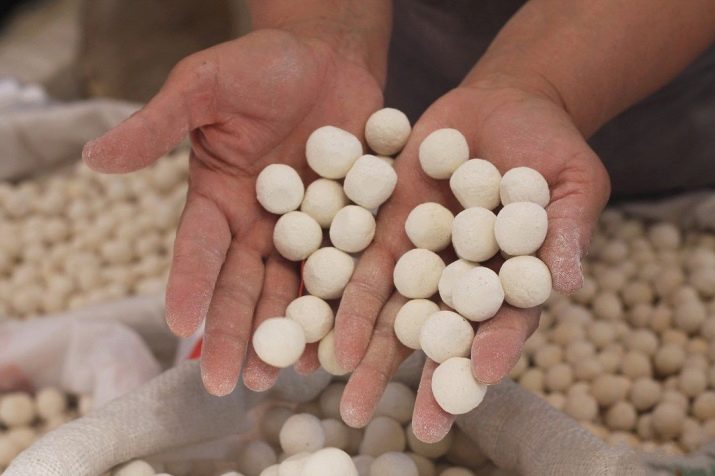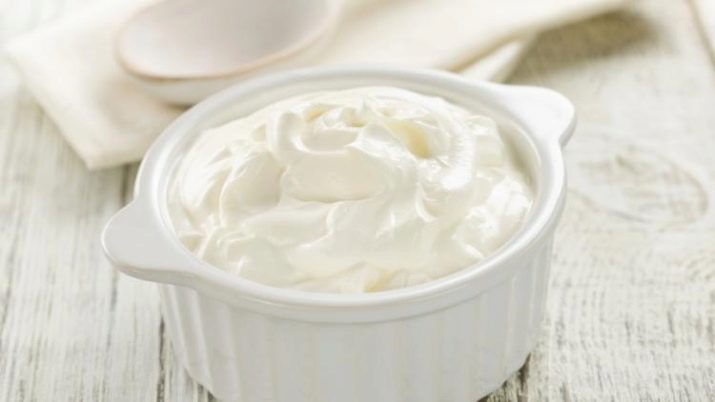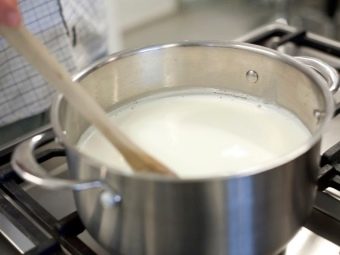Kurut: properties and cooking recipes

National dishes not only demonstrate the generosity and breadth of the soul of the people, but also have a very tangible practical meaning.They were created in accordance with the characteristics of climate, habitat and ensured the survival of people in certain periods. It happened with kurut.
What it is?
Kurut (kurt) is a fermented milk dish that represents dried balls. To taste, they simultaneously resemble both cottage cheese and cheese, have a salty flavor and fermented milk flavor. It is more correct to call kurut dry young cheese. A dish appeared in Central Asia and was originally a food of nomads. White balls are very nutritious, but they can be stored for a long time and are easily transported without taking up much space.
At the heart of kurut goat, cow or sheep milk. In the southern territories of Kazakhstan, the dish was prepared from mare's milk, in the western - from camel's milk. The sizes of the balls are small - about apricot, although Bashkirs preferred kurut the size of an orange. Various spices can be added to them, which affects the taste and tint of the balls.
They are used in a dry form, used as a seasoning, added to fatty soups and broths, or diluted with milk or kefir to obtain a satisfying drink. Under certain temperature conditions and humidity levels, the product is stored for up to 7-8 years.
To prepare the dish, milk should first be turned into a katyk, removing moisture from it. The result is a condensed milk mass, which is distributed in gauze bags and suspended for several days. During this period, the liquid completely flows out of the mass, the suzme remains in the bag. It can be used as a standalone product. But if you salt it and form balls, which are dried in the sun for several days, you will get cool.
It must be dry enough to be hard as a stone. The harder it is, the longer the product is stored.
In ancient times, Kurt was highly appreciated. Due to its nutritional value and versatility of use, it was considered a satisfying food and could turn into a full-fledged lunch, dinner, or simply could quickly support its strength. It was very valuable for nomadic warriors - a bag with a kurut was tied to the saddle, thanks to which it was possible to refuse to use the field kitchen and speed up the movement of troops, improve its maneuverability.
In addition, Kurt was stored for a long time and allowed to use a large amount of milk, avoiding its souring. In Asia, it was often dried for future use and used as bread. Since the dish contains vitamin C and other vitamins and minerals, and also has a high nutritional value, it was included in the menu of the wounded and weakened people. Due to its antibacterial and antiseptic properties, the product was used to treat the umbilical cord of newborns.
Today kurut can have several varieties:
- dried salted product, which is obtained by abundant salting of fermented milk mass and its long-term drying in the sun, has the appearance of balls or cylinders and has the saltiest taste;
- boiled and dried kurut is prepared by pre-digesting the milk mass, after which balls are formed from it, which are dried in the sun, the dish has a more delicate creamy taste and aroma;
- pasty - raw materials are also boiled, but not dried, but are stored in storage tanks, used to add to soups and liquids.
Benefit and harm
Kurut contains a large amount of vitamin D and calcium, so it is useful for bones, teeth. Its consumption during pregnancy will help prevent the development of rickets in a child. It is useful for older people, whose calcium content in the body decreases, which increases the risk of fractures. If, after injuries and bone fractures, to use this type of cheese, the restoration of the skeletal system will be faster.
Kurut not only helps to get enough, but also perfectly quenches thirst. Nutritional value, like other healing properties, is largely due to the presence of fermented milk streptococci and nutrients in kurut.In the process of cooking, kurut is enriched with special microorganisms that improve the digestibility of the product.
Despite the fact that it is very concentrated, the body absorbs it completely.
Asian cheese is good for digestive organs. Possessing antibacterial properties, it inhibits the pathogenic intestinal microflora, contributing to the development of beneficial. As a result, a person not only gets rid of poor digestion and its consequences, but also enhances its protection against intestinal infections.
The product has the ability to relieve nausea attacks, which can be useful for some diseases, while traveling, during pregnancy. Eastern healers recommended cheese for exhaustion, anemia. It will be useful at elevated physical, including sports, loads, intellectual fatigue.
It is rich in proteins, so it will help build muscle mass, will have a positive effect on the condition of the bone system, teeth and hair.
Vitamin composition is represented by vitamin A, involved in the production of sex hormones, contributing to the improvement of the organs of vision. Together with vitamin E, it participates in the renewal of cellular structures, is responsible for saturating them with oxygen, and reduces the rate of age-related cell changes. Ascorbic acid has an immunostimulating effect, increases the body's resistance to environmental factors, colds, infections. This is very important, as a lack of vitamin C entails apathy, fatigue, problems with blood vessels.
The high content of vitamins of group B, which makes Kurt useful for the nervous system, skin. It helps to strengthen the nerves, relieves anxiety, relieves insomnia. The mineral composition, in addition to calcium, includes iron, copper, sodium, potassium, magnesium, phosphorus. The product is useful for arthritis and other articular diseases that cause stiffness. The presence of proteins, zinc and vitamins of group B makes the product valuable for men's health. The content of testosterone in the blood increases, the quality of sperm improves, which affects reproductive performance.
When consuming, remember that Kazakh, like every other kurut, is quite high in calories. The energy value is 260 kcal per 100 g of product. At the same time, the product is rich in fats - 100 g covers up to 50-70% of the daily body need for fats. It is necessary to consume a dish with care, especially at obesity, a diabetes mellitus. Excessive use can cause problems with the digestive tract - abdominal pain, nausea, vomiting, diarrhea.
From the product should be discarded with lactose intolerance. Saturation of fats leads to an increase in cholesterol, so kurut is not recommended for people suffering from cardiovascular diseases, atherosclerosis.
Pregnancy is not a contraindication to the reception of cheese, but it should be eaten with caution, reducing the dosage.
Preference should be given to heat-treated varieties. In the raw kurut, dangerous listeria bacteria can persist. They provoke diseases that can lead to miscarriage and fetal death.
During lactation, it is better to reject the product - the likelihood of allergic reactions in the infant is high. The high salt content makes this cheese dangerous in case of problems with the liver and kidneys, hypertension. But even a healthy person should not abuse kurut saturated with sodium. This provokes swelling, deterioration of all body systems.
Cooking recipes
At enterprises, Kurt is prepared by cleansing and pasteurizing milk. Then the mixture is cooled to 50 ° C. Sour-milk bacteria protruding like leaven are introduced into it. After ripening, a tight clot is formed, which is decanted and then pressed under the influence of high temperature. Then salt is added, the composition is distributed in forms, where it freezes. Ready balls are prepared for sale.
As a rule, the fat content of the product is 7%.You can get a fat-free analogue, remove the cream from the milk, turning it into fat-free.
To make cheese at home, you first need to make a katyk. The finished drink purchased from the store will not work, it does not have the desired fat content, it may have preservatives and other additives. Then, from 3 liters of goat or sheep milk and 500 ml of katyk, you need to make a leaven by mixing these ingredients.
The mixture should ferment for 3-4 days, after which the fermented mass should be set on fire. You should use thick-walled dishes so that when the liquid is evaporated, the raw materials do not burn. Optimum fit wide dishes with high walls.
The evaporation time depends on the desired consistency of kurut. If it is added to soups and applied as a paste, it is enough that the volume of the mass is halved.
If it is intended to roll the balls, then it is necessary to weary the milk until, by its consistency, it starts to resemble milk. Now you should salt salt to taste (usually 1 tablespoon of water is taken for 1 l of liquid). From a dense mass roll balls and dry them in a well-ventilated place, laying out in one row for several days. Pasty kurut can be decomposed into cans, closed and stored in the refrigerator.
How to use?
Kurt can be used as a separate dish or added to salads, main dishes. It goes well with vegetables, but when consumed with meat, food may be overly heavy. If you add cheese to broths, they acquire richness, creamy taste, and in addition, level its excessive fat content. If you dissolve the product in koumiss, katyk, kefir or even water, you get a nutritious fermented milk product.
You can serve salted balls to alcoholic beverages, according to tradition, these dishes are harmonious with beer, kvass. You can also serve it along with kefir. Due to the high caloric content it is better to consume Kurt up to 16-18 hours. It is not recommended immediately before bedtime - due to excessive fat, possible heartburn, nausea.
See the video recipe of cooking kurut below.































